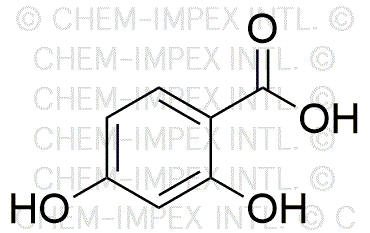2,4-Dihydroxybenzoic acid is widely utilized in research focused on:
- Pharmaceutical Development: This compound serves as a precursor in the synthesis of various pharmaceuticals, particularly in the formulation of anti-inflammatory and analgesic medications.
- Cosmetic Industry: It is incorporated into skincare products due to its antioxidant properties, helping to protect the skin from oxidative stress and improve overall skin health.
- Food Preservation: The compound acts as a natural preservative, extending the shelf life of food products by inhibiting microbial growth, making it valuable for food manufacturers.
- Analytical Chemistry: Used as a reagent in various analytical techniques, it helps in the detection and quantification of other compounds, enhancing the accuracy of laboratory results.
- Agricultural Applications: It is explored for its potential as a plant growth regulator, promoting healthier plant development and improving crop yields in sustainable farming practices.
General Information
Properties
Safety and Regulations
Applications
2,4-Dihydroxybenzoic acid is widely utilized in research focused on:
- Pharmaceutical Development: This compound serves as a precursor in the synthesis of various pharmaceuticals, particularly in the formulation of anti-inflammatory and analgesic medications.
- Cosmetic Industry: It is incorporated into skincare products due to its antioxidant properties, helping to protect the skin from oxidative stress and improve overall skin health.
- Food Preservation: The compound acts as a natural preservative, extending the shelf life of food products by inhibiting microbial growth, making it valuable for food manufacturers.
- Analytical Chemistry: Used as a reagent in various analytical techniques, it helps in the detection and quantification of other compounds, enhancing the accuracy of laboratory results.
- Agricultural Applications: It is explored for its potential as a plant growth regulator, promoting healthier plant development and improving crop yields in sustainable farming practices.
Documents
Safety Data Sheets (SDS)
The SDS provides comprehensive safety information on handling, storage, and disposal of the product.
Product Specification (PS)
The PS provides a comprehensive breakdown of the product’s properties, including chemical composition, physical state, purity, and storage requirements. It also details acceptable quality ranges and the product's intended applications.
Certificates of Analysis (COA)
Search for Certificates of Analysis (COA) by entering the products Lot Number. Lot and Batch Numbers can be found on a product’s label following the words ‘Lot’ or ‘Batch’.
*Catalog Number
*Lot Number
Certificates Of Origin (COO)
This COO confirms the country where the product was manufactured, and also details the materials and components used in it and whether it is derived from natural, synthetic, or other specific sources. This certificate may be required for customs, trade, and regulatory compliance.
*Catalog Number
*Lot Number
Safety Data Sheets (SDS)
The SDS provides comprehensive safety information on handling, storage, and disposal of the product.
DownloadProduct Specification (PS)
The PS provides a comprehensive breakdown of the product’s properties, including chemical composition, physical state, purity, and storage requirements. It also details acceptable quality ranges and the product's intended applications.
DownloadCertificates of Analysis (COA)
Search for Certificates of Analysis (COA) by entering the products Lot Number. Lot and Batch Numbers can be found on a product’s label following the words ‘Lot’ or ‘Batch’.
*Catalog Number
*Lot Number
Certificates Of Origin (COO)
This COO confirms the country where the product was manufactured, and also details the materials and components used in it and whether it is derived from natural, synthetic, or other specific sources. This certificate may be required for customs, trade, and regulatory compliance.


